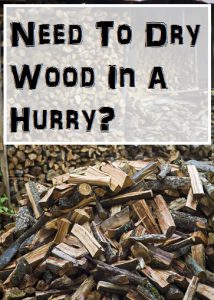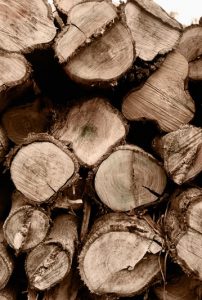I hope you love the products I've recommended below, just a heads up that as an Amazon associate, I earn from qualifying purchases. This means I may earn commissions on products bought via links on this page.
Whether it’s a late summer camping trip or a cold winter’s night staying at home, nothing beats a roaring fire. It brings light and a source to heat food when you’re out in the wilderness and allows you to heat your home in a quaint or even functional way.
That said, if you’re planning on having a fire in any capacity, then you’re going to need to know the best way to dry firewood fast. It’s true that for some things, you may be able to chop some firewood as needed. But for most situations, that won’t be true. Wood that’s too moist simply struggles to catch alight, which means you’ll need to dry out the wood before you can use it.
If you’re not certain how to dry out the wood, then here are a few tips.
Preparing The Wood For Drying
You’ll want to start preparing long before you actually need the wood if you want to ensure it’s dry. Six months before you need it is a fairly good rule of thumb, though some types of wood will need a longer or shorter period of time. If possible, you should prepare your firewood a year in advance. This means it’s best if you start a constant pile of firewood, replenishing whenever it begins to get low. That way, you have a constant supply of firewood. Keep the wood in a similar fashion to how you would rotate food in the pantry/fridge. First in, first out so that way all the timber is evenly rotated and has appropriate amounts of time to dry.
Splitting The Logs Fast And Efficiently
Start by chopping the wood into round logs. Once you have the traditional log shape, split it in half. For the fastest and safest results, we highly recommend the use of a Log Splitter. This will shave an incredible amount of time of your workload and also be easier on the shoulders and back.
There are several types of log splitters you can use. Depending on your situation there’s affordable home models and splitters that go all the way up to commercial status. Below you can find more information on the types of log splitters available, starting from the cheapest and going up to the more expensive types.
- Manual Log Splitters – Cheapest But More Labor Intensive
- Electric Log Splitters – Best For Home Use
- Gas Powered Machines (Heavy Duty)
At that point, you should begin using the split pieces to create “bookends”. These are stacks of wood that allow you to more easily make a pile.
In order to make bookends, place three split logs next to each other. Then place three more split logs on top of those, laying them across the bottom row. Continue stacking and crisscrossing the logs as you build, until you get to a height of about 4 feet.
Stacking The Wood For Quicker Drying
The book ends are the most important part of the stack. However, you’ll also need to do a bit of geometry. Specifically, you’ll need to figure out how wide the average split log is. You’ll then need to figure out how many of those logs will fit between your two bookends. That way, you can lay the wood neatly in rows. This allows you to stack them in a uniform way while still giving them plenty of space to breathe and dry.
If you live in a more humid climate, then you may wish to cover your woodpile. This is especially true if your area sees a lot of rainfall. It would be terrible to set up wood to dry, only to have a heavy rain set you back months.
Checking The Firewood For Dryness
Once time has passed, you’ll begin seeing signs that the wood is drying. Most wood gets darker as it dries, though there are a few exceptions to the rule of course.
You can also smell a piece of wood and see if you can find the scent of sap. When wood is freshly chopped, it has a strong sap smell clinging to it. That sap smell goes away as it dries, and once the wood is fully dry it’s gone completely. After much experience cutting and drying firewood, this smell will become natural. In the beginning, it may be difficult to determine which stage the log is at.
Lastly, if you’re still in doubt, you can simply build a fire. After all, you want firewood. So you may as well give it a trial by fire, so to speak!
Of course, if you want to speed up the process then you simply start with a wood that tends to be dry on its own. Woods such as ash and other dry woods can dry out more quickly. In addition, laying the wood near heat will help it dry out more quickly. If you are using an outdoor fire pit, you could dry out moist firewood by placing it on a wire rack over the firepit. Some fire pits have this feature built into the pit.
In A Hurry?
Not everyone has time to wait several months if not a year for their wood to dry and require it to be dry much quicker. Thankfully there is a way to dry your wood quicker that most people will have the ability to do tho it can be a little expensive so it might not be a possibility for some.
This is to use your oven to dry out the wood which is easily the quickest way to dry your wood and is something that can extremely useful. While this isn’t something that you could rely on if you use wood for everything, but for those who are just looking to have a firepit going it can be extremely useful.
You don’t have to leave the wood out for a year and it can easily be done in even a couple of hours. So it’s something that I think most firewood users should learn since it’s a useful skill to have.
I have put together a guide for those who want to learn how to do it the safe and right way which I recommend reading if you want to try this. While it’s not difficult to do this, there are a few things I recommend everyone learn before doing so I highly recommend my guide.
A Brief Overview Of How To Dry Your Firewood In Your Oven
While I recommend you read my in-depth guide I will go over the basics of how to dry your wood via your oven. I will give a brief overview of how to do this for those who are looking for a quick guide.
Step 1
The first step you will want to do is to turn your oven on to about 200 – 225 degrees F and let it come to this temperature which shouldn’t take to long. If your oven has a convection fan then you will need to turn that on as well.
Step 2
Next, you will want to load the wood on the oven racks and there are a few things you will want to look out for here. You will want to make sure the wood isn’t touching or only a very minimal amount of touching. You will want to make sure none of the wood will fall through the rack so including even the smaller pieces.
You will also want to add a tray with water at the bottom of it to help with humidity and is a crucial step.
Step 3
This next step is to leave the wood in the oven for an hour while checking on it constantly to make sure it hasn’t caught on fire. You will want to remove pieces to check to see if there is still moisture in the wood which can be difficult and I find the easiest to use a tool. If there is still moisture you will want to put it back in the oven and test again after 15 minutes.
Step 4
The last step is to remove the wood and store it in a safe place to let it cool down which you will need to check on it to make sure it hasn’t caught on fire. I would recommend checking the wood for moisture again to make sure it’s ready and if it’s not you will need to put it back in the oven.
Just Remember To Stay Safe
This can be a dangerous job so I recommend taking extra special care while doing it by wearing things like oven mitts or something stronger. I also recommend staying around the oven while you’re doing this as it can be dangerous and you don’t want it to catch fire while you’re not around.
If there is smoke or fire I recommend turning off the oven and leave the door closed and let it burn itself out. You will need to wait a bit before you can open the oven and I’d recommend opening all doors and windows in the house. If the fire persists then I recommend calling the fire department and leaving the house.






